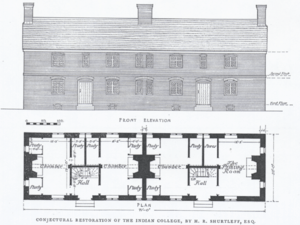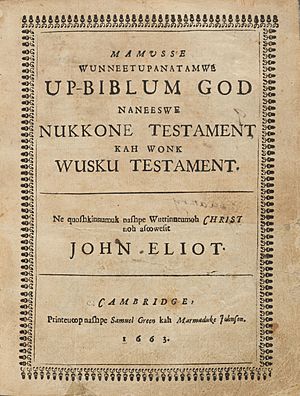Harvard Indian College facts for kids
The Indian College was a special school built in the 1640s. It was part of Harvard College in Cambridge, Massachusetts. Its main goal was to educate Native American students.
The college building was finished in 1656. It had a printing press inside. This press was very important. It printed the first Bible translated into a Native American language, called the Eliot Indian Bible, in 1663. This was also the first Bible ever printed in British North America. A charity from London called the Society for the Propagation of the Gospel in New England helped pay for the Indian College.
The Indian College did not have many students. It closed in 1693. The building was taken down, but some Native American students still went to Harvard later. The bricks from the old building were used again for other buildings at Harvard. In 1997, Harvard put up a special plaque to remember the Indian College. In 2009, parts of the original building and printing press were found during an archaeological dig.
Contents
History of the Indian College
Why the College Started
In the 1640s, Harvard College leaders wanted to educate local Native Americans. They also hoped to teach them about Christianity. Harvard's official goal in 1650 became "the Education of the English and Indian Youth of the Country."
Harvard got money from the Society for the Propagation of the Gospel in New England (SPGNE). This group paid for a new two-story brick building. It was the first brick building in Harvard Yard. This building, the Indian College, was finished in 1656. It was big enough for about twenty students. However, no Native American students were ready when it opened. So, English students used the building instead at first.
The Printing Press
The Indian College building held the first printing press in the English colonies. A missionary named John Eliot used this press. He printed a translation of the Bible into the Massachusett language. This book, known as the "Eliot Indian Bible", was very important. It was the first Bible printed in British North America. It was also the first full Bible translated into a Native American language.
Many Native Americans helped with this huge project. James Printer, a Nipmuc man who spoke Algonquian, did much of the translation and setting up the pages. Other Native Americans like Cockenoe, Job Nesuton, and John Sassamon also helped. Sassamon had studied at Harvard before the Indian College was built.
The press printed 15 books in Algonquian languages. It also printed 85 books in English. By 1680, the printing press was no longer used. Harvard officially stopped using it in 1692.
Native American Students
Only four or five Native American students lived in the Indian College building. Just one student, Caleb Cheeshahteaumuck, actually graduated from Harvard. Here are some of the students who attended:
- Caleb Cheeshahteaumuck and Joel Hiacoomes were classmates. They were from the Wampanoag tribe on Martha's Vineyard. They went to a special school first. They were supposed to graduate from Harvard in 1665. A few months before graduation, Hiacoomes went to visit family. On his way back, his ship was wrecked near Nantucket. He was never seen again. Caleb Cheeshahteaumuck graduated successfully. But he died a few months later in Watertown, Massachusetts, probably from a disease called tuberculosis. His speech in Latin to the college leaders has been saved.
- John Wompas started in 1666. But he left the next year to become a sailor.
- A student named Eleazar started in 1675. He got smallpox soon after and died.
- Some people believe that Daniel Takawambait, one of the first ordained Native American ministers, also attended the Indian College.
Why the College Closed
Many Native Americans got sick when they were close to the English community. Because of this, the building was not used much for its main purpose. When Harvard Hall was finished in 1677, the English students moved out of the Indian College. The building then became empty.
In 1693, Harvard wanted to use the bricks from the Indian College building for a new construction. They asked the Society for the Propagation of the Gospel in New England for permission to tear it down. The Society agreed, but only if Native American students could study for free in the new building. By 1698, the old building was taken down. Its bricks were used to build the first Stoughton Hall.
Legacy of the Indian College
Even after the Indian College building was gone, some Native Americans still attended Harvard. Benjamin Larnell, another member of the Nipmuc tribe, went to Harvard in the early 1700s. John Leverett the Younger, who was Harvard's president, wrote about Larnell. He said Larnell was very good at Latin and Greek poetry. Judge Samuel Sewall sent copies of Larnell's poems to London. He wanted to show how well Native Americans were being educated. Sadly, those poems have not survived. Larnell died of a fever in 1714 when he was about 20 years old. One of his Latin poems, about Aesop's fable of the fox and the weasel, was found again in 2012.
In 1997, a special ceremony was held at Harvard Yard. A historic plaque was placed there to remember the Indian College. About 300 people attended this event.
|



